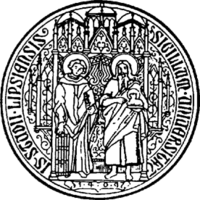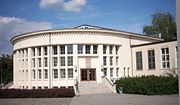University of Leipzig
| University of Leipzig | |
|---|---|
| Universität Leipzig | |
 |
|
|
Latin: Alma mater Lipsiensis |
|
| Established: | December 2, 1409 |
| Type: | Public |
| Rector: | Franz Häuser |
| Staff: | 3,196 (2005) |
| Students: | 29,668 (winter 2006/2007) |
| Location: | |
| Campus: | urban |
| Website: | www.uni-leipzig.de/ |
The University of Leipzig (German: Universität Leipzig), located in Leipzig in the Free State of Saxony, Germany, is one of the oldest universities in Europe. It has a long tradition of globally oriented and culturally comparative historical research and tertiary-level teaching.
The university was founded on December 2, 1409 by Frederick I, Elector of Saxony and his brother William II, Margrave of Meissen, and originally comprised four faculties. Since its inception the university has enjoyed almost 600 years of uninterrupted teaching and research.
Contents |
History
Founding
The university was modelled on the University of Prague, from which the German-speaking faculty members withdrew to Leipzig after the Jan Hus crisis and the Decree of Kutná Hora. The Alma mater Lipsiensis opened in 1409, after it had been officially endorsed by Pope Alexander V in his Bull of Acknowledgment on (September 9 of that year). Its first rector was Johann von Münsterberg.
Between 1953 and 1991, the university was called Karl-Marx-University.
University Library
The University Library of Leipzig was established in 1543. It is one of the oldest German university libraries and it serves as a source of literature and information for the University of Leipzig as well as the general public in the region. Its extensive historical and special collections are nationally and internationally recognized. The library consists of the main building "Bibliotheca Albertina" and forty branches situated near their respective academic institutions. The current stock comprises 5 million volumes and about 7.700 periodicals. Collections range from important medieval and modern manuscripts to incunabula, papyri, autographs, ostraka and coins.
Campus
The university's urban campus comprises several locations. The main building in the center of Leipzig went under construction in 2005; the blueprints for the new university building were drafted by Dutch architect Erick van Egeraat. The estimated total cost for the renovation project is 140 million euros. The new building is set to finish in 2009, just in time for the university's 600th anniversary celebrations.
Besides the faculties and institutions, there are several other bodies that serve the university: University Library, a university archive and administration, as well as a museum for music instruments and a university clinic. The university's Botanischer Garten (botanical garden) was established in 1542 and it is the second oldest botanical garden in Europe. All in all, the university is spread across 38 locations in Leipzig.
Academics
Today, the university has 14 faculties. With over 29,000 students, it is Saxony's second-largest university. There are now more than 150 institutes and the university offers 190 study programs leading to Bachelor's degrees, Master's degrees, Staatsexamen, Diplom[1] and Ph.D.s of which nearly all are tuition-free. Arguably, the Faculty of Medicine is the university's most renowned faculty.
The university offers a number of courses in English and other foreign languages and there are several programs allowing foreign students to study abroad at the university. Current exchange partner universities include University of Arizona, University of Houston, University of Alberta, and University of Edinburgh among others.
There are two Master's programs (American Studies and Global Studies) and one Bachelor/Master's/Ph.D. program (International Physics Studies Program[2]) taught in English. American Studies Leipzig is one of the most distinguished programs of its kind in Europe. In the last three years alone, it has been awarded three prestigious international professorships: The Fulbright-Leipzig Chair for American Studies, the DAAD Professorship for American and International Studies, and the Picador Chair for Literary Studies. It is also the home of aspeers:emerging voices in american studies, a graduate-level peer-reviewed scholarly journal for American studies. Erasmus Mundus Global Studies on the other hand, is an interdisciplinary, research-based Master offered by a consortium of four European universities: University of Leipzig, the London School of Economics, University of Vienna, and University of Wroclaw.
The university is ranked 5th in Germany, 29th in Europe and among the best hundred in the world by the web-based Webometrics Ranking of World Universities.
Faculties

The original four facilities were the Faculty of Arts, Theology, Medicine, and Law. Today, the university comprises the following 14 faculties:
- Faculty of Theology
- Faculty of Law
- Faculty of History, Art and Oriental Studies
- Faculty of Philology
- Faculty of Education
- Faculty of Social Sciences and Philosophy
- Faculty of Economics and Management (including Civil Engineering)
- Faculty of Sports Science
- Faculty of Medicine (with a University Hospital)
- Faculty of Mathematics and Computer Science
- Faculty of Biosciences, Pharmacy and Psychology
- Faculty of Physics and Earth Science
- Faculty of Chemistry and Mineralogy
- Faculty of Veterinary Medicine
People associated with the University of Leipzig
University of Leipzig has produced many notable individuals. Some famous people affiliated with Leipzig include:
- Johann Wolfgang Goethe, German poet and polymath
- Angela Merkel, first female German Chancellor
- Gustav Hertz, German physicist, Nobel Prize in Physics
- Friedrich Nietzsche, German philosopher
- Richard Wagner, German composer
- Wilhelm Wundt, German psychologist, founded the first formal laboratory for psychological research
- Gotthold Ephraim Lessing, German philosopher and writer
- Hans-Dietrich Genscher, German politician, Foreign Minister and Vice Chancellor
- Werner Heisenberg, German physicist, Nobel Prize in Physics
- Gottfried Wilhelm Leibniz, German polymath
- Ferdinand de Saussure, linguist, founder of structuralism
See also
- Leipzig school (sociology)
- Handelshochschule Leipzig (HHL)
- Category:University of Leipzig alumni
- Category:University of Leipzig faculty
References
- ↑ Since the adoption of the Bachelor's degree and Master's degree only three study programs leading to Diplom have remained: Maths, Mathematical economics and Protestant Christian Theology.
- ↑ Homepage of the International Physics Studies Program at Leipzig
External links
- (German) (English) University of Leipzig Website
- (German) (English) Leipziger Universitätsverlag Publishing House
- American Studies Leipzig website
 "University of Leipzig". Catholic Encyclopedia. (1913). New York: Robert Appleton Company.
"University of Leipzig". Catholic Encyclopedia. (1913). New York: Robert Appleton Company.
|
||||||||